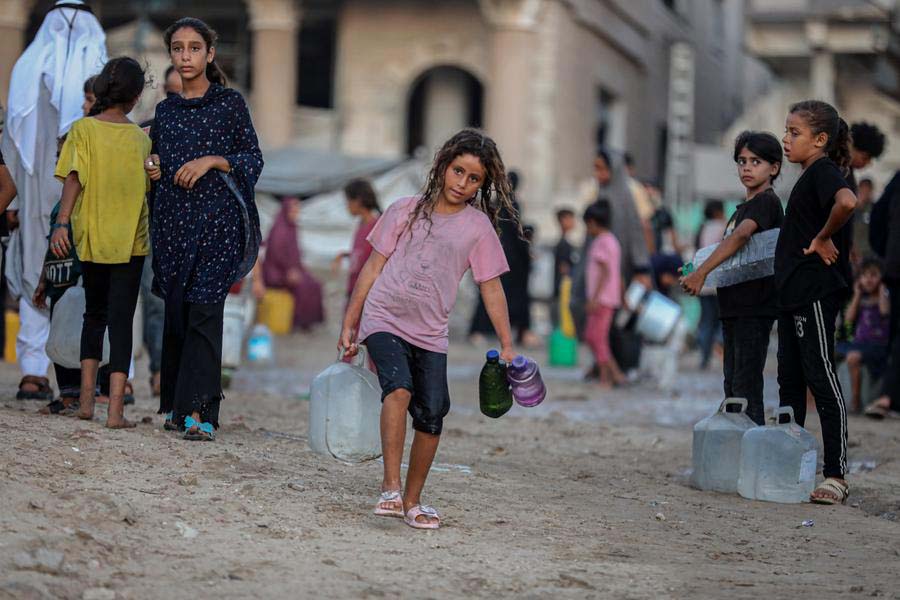Distressed children of the Gaza strip
Gaza records about 130 births daily, but "some may not survive complications at birth," with the healthcare system driven to the verge of collapse, according to an April report by Save the Children, a London-based international non-governmental organization.
Palestinians wait to receive free food at a camp for displaced people in southwest Gaza City, on August 24, 2025. (Xinhua Photo)
By AFP .
Journalists @New Vision
GAZA - Children in the Gaza Strip, making up roughly half of the population, are among the most vulnerable during the ongoing conflict. What difficulties are they facing? How will they endure the spread of famine and subsequent trauma?
Gaza records about 130 births daily, but "some may not survive complications at birth," with the healthcare system driven to the verge of collapse, according to an April report by Save the Children, a London-based international non-governmental organization.
"The survival of mothers and newborn children in Gaza is under particular threat due to the lack of food, destruction of hospitals, and chronic stress," the report added, citing a 300 percent surge of miscarriages and life-threatening pregnancy complications that would be treatable before the conflict.
It noted that malnutrition during pregnancy can "seriously affect a baby's development, leading to low birth weight, stunted growth, and long-term difficulties in learning and development."
At Al-Shifa Hospital in Gaza City, three-week-old Nour al-Sawafiri lies in an incubator attached to wires and a ventilator. Her mother Nidaa watches the screen every minute, fearing losing her at any moment.
"She was born prematurely, weighing barely one and a half kilograms. Her health requires constant monitoring, but the hospital lacks everything from staff to equipment to electricity," Nidaa told Xinhua.
Fifteen percent of the total population in the Gaza Strip is under four years old, with 47 percent under 18, according to a Palestinian Central Bureau of Statistics report in July.
"This youthful demographic structure highlights the urgent need to invest in key sectors such as education, healthcare and employment" to be empowered for shaping the future of Palestine, the report said. Yet their future has become a luxury dream amid the ongoing escalation of hostilities.
Between early July and mid-August, child protection partners observed a noticeable rise in child labor, with more children engaged in hazardous activities such as rubble collection, street vending and informal work in markets, as well as an increase in visible begging among children and women in urban areas, according to a UN report in August.
A Palestinian child fetches water near the beach west of Gaza City, on August 18, 2025. (Photo by Xinhua)
Lasting trauma
Eight-year-old Hala Emad survived an airstrike in Deir al-Balah city in the central Gaza Strip a year ago without physical wounds. Yet the event was traumatizing, forcing her to wake up in panic at every loud sound, often hiding under the blanket.
"She no longer plays or smiles. She spends her days in silence and tears. Even normal sounds like doors slamming trigger her fear," her grandmother Sara told Xinhua, noting that the once active girl avoids other children and rarely speaks, only staring at the ground as if somewhere far away.
Hala often clings to her granny at night, asking if their house will ever be rebuilt. Yet the family has no access to any psychological support.
Psychosocial distress is widespread, particularly among children who have been repeatedly displaced, with growing reports of children experiencing nightmares, social withdrawal, aggression and anxiety, a UN report said in August.
"The loss of parents or houses, or even exposure to bombings, leaves children in a constant state of fear, disturbing sleep, eating habits and communication," Gaza-based psychologist Mahmoud Al-Attarhe said, citing rising cases of bed-wetting, stuttering and prolonged silence.
"Childhood in Gaza is being buried under siege and destruction," Al-Attarhe added.
Another psychologist Sami Abu Salim warned that growing up in constant fear may leave permanent scars that last into adolescence and adulthood.
"Without long-term psychological support, a whole generation could grow up carrying chronic disorders," he said.

Palestinian child Jihad Saad is pictured at the Al-Rantisi Children's Hospital in Gaza City, May 4, 2025. (Photo by Xinhua)
Starved by design
At six years old, Misk al-Madhoun weighs just five kilograms -- roughly the weight of a two-month-old infant. Suffering from cerebral atrophy since infancy, she now lies limp and silent in northern Gaza, her body wasting away as the ongoing conflict deprives the enclave of even the most basic means of survival.
"We had financial difficulties even before the war," her father Bilal told Xinhua. "Now we can't find anything -- no treatment, no food. Humanitarian aid has almost disappeared."
A UN-backed report on Friday confirmed famine in parts of the Gaza Strip, marking the first officially declared famine in the Middle East and increasing pressure on the international community to ramp up supplies and on Israel to lift restrictions on aid.
"Children in Gaza are being starved by design by Israeli authorities. This was a wholly predictable and avoidable tragedy that humanitarian organizations have been warning about for months," said Ahmad Alhendawi, Save the Children's Regional Director for the Middle East, North Africa and Eastern Europe.
In July, UN partners reported more than 13,000 admissions of acutely malnourished children in Gaza, double the number of admissions recorded in June and more than a six-fold increase compared with the 2,000 admissions in February.
"The pace of this deterioration is alarming, and demands an urgent, scaled-up response," the United Nations Children's Fund alerted.
"For children, conditions like malnutrition can lead to lifelong health issues like stunting, weakened immune systems and organ failure," Alhendawi cautioned. "The effects of malnutrition can span generations, with its impacts on children making learning and development harder, creating a cycle of poverty for the entire population."
Born also with cerebral atrophy, 15-year-old Tamer Shohaiber died of malnutrition-related complications at al-Aqsa Hospital in Deir al-Balah in early August.
"In his final days, we couldn't secure even basic food such as flatbread," said his grieving mother.
Gaza-based health authorities on Sunday said eight more people died of malnutrition and starvation, raising deaths from such causes to 289 people, including 115 children, since the latest round of the Palestinian-Israeli conflict broke out in October 2023.
